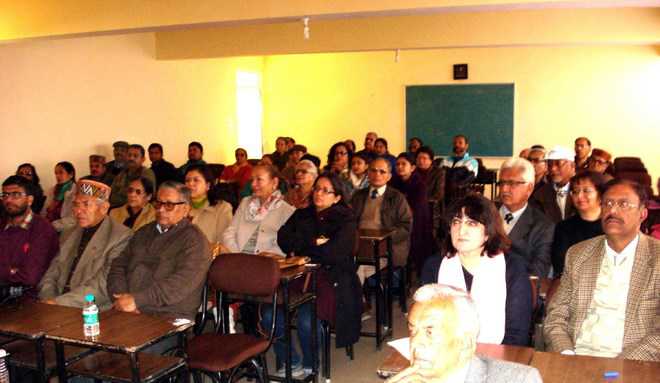
Shriniwas Joshi
SHIMLA Amateur Garden and Environment Society (SAGES) in its annual general meeting picks up the subjects which are instrumental in keeping up the environment of the state in a happy position. Vaneet Jishtu, a botanist in the Forest Research Institute, (see photo) Shimla, took up the subject of 'Threat of invasive plants on natural flora' in a recently held meeting at Laureate Public School complex.
The house was all attentive (see photo) to Vaneet who says, "Drive up the Kufri-Chail Road and you will find the slopes dominated by blue pine, which is an invasive exotic species that is gradually edging out the local oak." What is an invasive plant? The federal definition of invasive plants is a non-native species whose introduction causes or may cause economic or environmental harm or may also impair the human health. I believe that most of these plants cause little trouble but some are responsible for degrading thousands of acres of natural plant communities here. Control efforts, if any done by the forest department, are costing us - the taxpayers.
Vaneet's statement that about 450 species of alien flora have found space in Himachal Pradesh of which 30 per cent have become invasive, is alarming. He says, "All invasive species have come from tropical America and Australia and major tree species introduced here are eucalyptus, acacia's (wattles), prosopis juliflora, leucaena leucocephala etc. of which eucalyptus occupies about 25 per cent of India's plantation area."
KS Dogra, RK Kohli and SK Sood of Himachal Pradesh University, assessed the impact of invasive exotic species on natural flora of Shivalik hills in the years 2002-04. Shivalik covers the lower hills of districts Kangra, Hamirpur, Una, Bilaspur, Mandi, Solan and Sirmaur. The altitude of this zone is from 244 to 1500 m above mean sea level.
The researchers say that Shivalik had a rich floral diversity but due to the invasion of exotic plants there is drastic reduction in the diversity of natural vegetation. "These exotic species possess certain traits that provide them competitive advantage over the natives and thus aid in their fast spread in the alien environment. It has greatly altered the structure of the natural ecosystem and caused a dramatic shift in the diversity and dynamics of natural flora."
The forest department is aware of the dangers of the attack of invasive plants and from the ecological, biodiversity, socio-economic and health point of view seriously expresses concern of the advance of these plants. Lantana, which in the villages is called phulnu booti or panch phooli, has occupied the forest and the non-forest areas having bad effect on floral diversity and availability of grass.
Parthenium hysterophorus, which is commonly known as congress grass or gaajar ghaas or chatak chaandni, has not only the adverse ecological impacts but also causes allergic reactions among the masses. Ageratum conyzoides or neel phulnu is posing a serious threat to indigenous vegetation in the state. Eupatorium adenophorum or crofton weed is a shrub of Mexico and forms dense thickets wherever it grows and edges out the indigenous species.
The forest department is also worried about the 'Speed of Spread' of these plants. The department says that more than 40 per cent of the infestation has taken place in the past decade only. Is the forest department doing something to check the menace? Most of the members present believed that it was 'just sleeping'. A reconnaissance carried out in the year 2011 had shown to the forest department that lantana has invaded 1.5 lakh hectares of forest land while the other three had covered 0.50 lakh of their land.
The department then started intervening but the scale of intervention was so low that the management efforts, revolving mainly around mechanical removal of the exotic weeds, have been too few and too far spread to create any significant effect. The past efforts have not yielded desired results due to lack of focus on long-term follow up system. Vaneet too concluded his presentation by saying, "Dilemma in our country is that action starts when the things go out of hand."
TAILPIECE
Collett records in Flora Simlensis, published in 1902, that ‘kshirakakoli’ or lilium polyphyllum, an ingredient of Chyavan Praash, was a common undergrowth of Deodar trees in Shimla and around. It has vanished from the state in the past 114 years.
— The writer is a retired bureaucrat



























